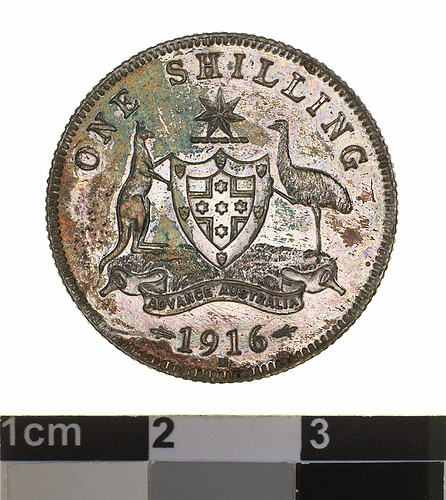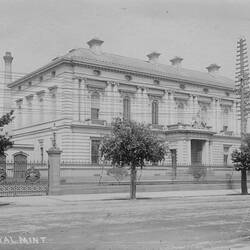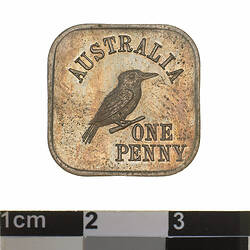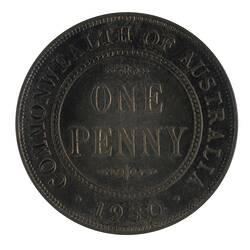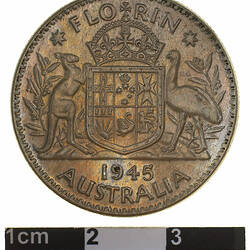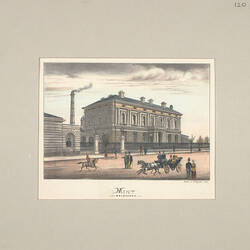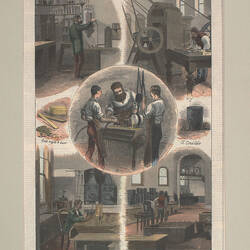Although the Commonwealth of Australia was formed in 1901, it was to be 1909 before any steps were made for a national coinage. In 1902 and again in 1911 British Imperial coins were authorised for use in Australia.
The Melbourne Branch of the Royal Mint had been established in 1872 to strike small diameter gold coins with dies provided from London and in 1901 that was still the situation. None of the branches of the Royal Mint (there were three in 1901 after the opening of Perth in 1899) was capable of designing or preparing dies for a Commonwealth coinage, and none had the machinery necessary for striking the larger diameter silver and bronze coins that would be needed.
Trial tools were made in 1909 by the Royal Mint in London, but no patterns or coins were struck. However in 1910 four silver denominations, identical in weight, size and silver content with the current British coins, but with the Australian arms and a crowned bust of King Edward VII were struck in London and shipped to Australia. In 1911 the penny and halfpenny denominations were added. All 1911 coins bore the head of the new king, George V.
The outbreak of World War I resulted in changes to the manufacture and shipping of Australia's coinage from Britain. The Royal Mint itself was to be heavily involved in manufacture of materials needed for the war effort. In 1914 and 1915 The Mint, Birmingham, a private mint established and managed by the Heaton family, was called upon to assist in filling the Australian orders (their mint mark, "H" appears on silver coins of those dates).
In 1916 it was decided to transfer production to Australia. The choice for the mint in Australia to strike the silver coins was between Melbourne and Sydney. Like Melbourne Mint, the Sydney Mint was under control of its state government. Sydney had been making a constant loss and the New South Wales government was talking to the Commonwealth about transferring the responsibility for the mint and completely redeveloping it at a new site. Melbourne too was not profitable but its buildings were in a good state of repair and its machinery was more up-to-date.
On 1 November 1915 Melbourne was instructed to prepare to strike silver coinage. As with the dies for the gold sovereign and half-sovereign, the dies for the silver florin, shilling, sixpence and threepence were made in London and bore the letter M, the Melbourne mint mark. They arrived at the mint on Christmas Eve 1915.
At that time mints took the raw materials for coining, then assayed, melted and alloyed it to the legal standards. Then they worked the bars to the necessary thickness and stamped the coining blanks from the metal strips. After that the blanks were treated to soften them for striking and raise the rims to keep the pressures needed in the coining presses to a minimum. They needed to be weighed and those too heavy or too light rejected. Then they were fed into the presses and struck while retained within a circular ring bearing the edge milling. After striking they were ejected from the press into a collection box and then examined to ensure they were well struck. All of these processes required new tooling at the mint. While the dies came from London, everything else was done in-house.
Between 1 November 1915 and 10 January 1916 all of these changes were made in time for the Governor of Victoria to ceremonially strike the first shilling. During the rest of 1916 the other denominations were also brought into production. The small threepence caused the most difficulty, while the large florin (2 shillings) caused the greatest wear on the small presses. In 1919 more powerful Taylor and Challen presses were put to work on the florin production. Since the introduction of Australia's own silver coinage the mint had been involved in the removal of British Imperial coins from local circulation. These were divided into two classes, those that could be re-issued and those that were deemed worn. The former were exported to other British Dependencies in the region, principally to New Zealand, but also to Samoa. The worn coins were melted and from 1916 the ingots were sold to the Commonwealth and then used by the mint to produce the new Australian silver coins.
Since 1911 there had been no new official importations of Imperial coins, although on occasions the Commonwealth found it necessary to return some of the coins which had been withdrawn to circulation. Only with the British going off sterling silver standard in 1920 were new issues of British coins not legal tender in Australia.
In 1916 the Commonwealth made arrangements for the Indian mint at Calcutta to strike Australia's bronze denominations. They too were supplied with dies from London, bearing the mint mark I. But with the end of the war and with Melbourne now possessing more powerful presses, the production of the penny and halfpenny denominations was also brought to the mint. It was now beginning to make its own dies for the Commonwealth coinage and was experimenting with the different steels available for die production. In 1919 and 1920 small dots were added in different places around the reverse of the penny dies as part of this steel experimentation.
With contracts from the Commonwealth for the silver coins, the Melbourne Mint made a profit from 1916, a profit transferred to the Victorian Treasury. This was looked upon with interest at the Sydney and Perth mints. They too demanded a share of the Commonwealth contracts. Melbourne however was by that time well ahead in the other stages of coin production. Sydney obtained a contract to strike halfpenny coins in 1919 and pence in 1920, while Perth obtained a contract for Pence in 1921. By this stage the Commonwealth Government had decided that there would be no mint marks on its coins, so from 1921 the M ceased to be employed.
References
Holland, Paul, "Australian Pre-Decimal Bronze Coinage", Journal of the Numismatic Association of Australia, Vol.17, pp. 16-20.
Sharples, J.P. "Australian Coins 1919 to 1924", Journal of the Numismatic Association of Australia Vol.1 pp. 4-18
Sharples, J.P. "Collecting Commonwealth Coins", Journal of the Numismatic Association of Australia, Vol.5, pp. 17-21.
More Information
-
Keywords
-
Authors
-
Article types
